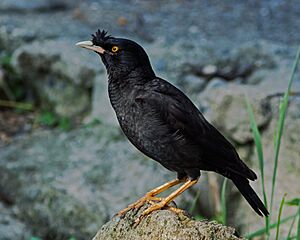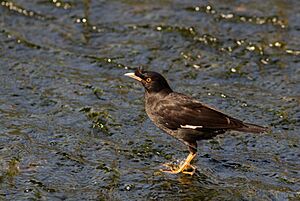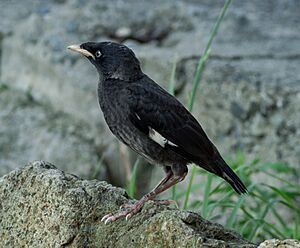Crested myna facts for kids
Quick facts for kids Crested myna |
|
|---|---|
 |
|
| Conservation status | |
| Scientific classification | |
| Genus: |
Acridotheres
|
| Species: |
cristatellus
|
| Synonyms | |
|
Gracula cristatella Linnaeus, 1758 |
|
The crested myna (Acridotheres cristatellus), also known as the Chinese starling, is a type of starling bird. It lives in southeastern China and Indochina. This bird gets its name from a special tuft of feathers on its forehead. These feathers look like a small crest.
You can often find crested mynas in open areas. They like places near cities and farms. People sometimes keep them as cage birds. Because of this, some have escaped and started living in new places. For example, some were brought to Vancouver, Canada, around 1890. Their numbers grew to thousands, but they are no longer found there.
Like many starlings, the crested myna eats many different things. It is an omnivorous bird. It eats worms, grubs, grains, fruit, and even leftover food. Farmers like these birds because they eat insects and do not harm crops.
Contents
About the Crested Myna's Name
The crested myna's scientific name is Acridotheres cristatellus. The word cristatella comes from Latin. It means "crested" or "plumed," which describes the feathers on its head.
Scientists recognize three main types, or subspecies, of the crested myna:
- A. c. cristatellus: Found in south and southeast China.
- A. c. brevipennis: Lives on Hainan Island and in Indochina.
- A. c. formosanus: Found in Taiwan.
What the Crested Myna Looks Like
The crested myna is mostly black. It has a slight green shine. It has white patches under its wings. These patches are easy to see when the bird is flying. The tips of its tail feathers are also white.
Adult mynas have orange eyes. Their beak is pale yellow and sharp. Their legs are a dull dark yellow. Male birds are a little bigger than females. The female's crest is not as big. Otherwise, males and females look very similar.
Baby mynas are born with very few feathers. They are mostly covered in soft gray fuzz. After about 18 to 20 days, young birds have brown feathers. Their crest is usually not fully grown yet. Young crested mynas have blue-gray eyes.
Where Crested Mynas Live
Crested mynas live in many different places. You can find them in cities and in the countryside. In cities, they live in buildings, along roads, and in parks. They also like parking lots, under bridges, and on roofs.
In the countryside, they are seen in farm fields and orchards. They often look for food near plowed fields. They also like to be near cows, eating insects around them. You can also find them in grasslands and at the edge of forests.
Their natural home is from southeastern and central China to northern Indochina. They are found in the Yangtze valley in China. They also live in Burma, Taiwan, and Hainan.
Because they are popular cage birds, they sometimes escape. This can lead to them living in new areas. For example, in the late 1800s, they were brought to Vancouver, Canada. Their population grew to tens of thousands. However, their numbers later dropped, and they are now gone from North America.
Crested mynas have also started living in other places. These include Portugal, Penang, Singapore, Manila, parts of Japan, and Argentina. In the Philippines, the crested myna is sometimes called "Martinez."
Crested Myna Behavior
Sounds and Calls
The crested myna makes many different sounds. These include whistles, warbles, and chortles. When it is scared, it makes a harsh jaaay sound. Other calls include a series of chuffs or creeks. Some mynas can copy human voices or other bird calls. However, mynas kept as pets are not usually good at copying sounds.
What Crested Mynas Eat
The crested myna is an omnivorous bird. This means it eats both plants and animals. It mainly eats insects. But it also eats fruit, grains, meat, and even garbage.
What they eat changes with the seasons. On average, adult mynas eat about 40% meat and 60% plants. In September, they eat more meat, especially flies. In winter, when insects and fruit are harder to find, they eat more garbage. About 15% of their winter diet is garbage.
Young mynas eat more animal matter than adults. About 75% of their diet is meat. Half of this meat comes from insects. Like adults, young mynas eat more insects and fruit when these foods are easy to find.
Reproduction and Life Cycle
Crested mynas build their nests in many different spots. In forests, they use holes in trees. These holes might be made by woodpeckers or from decay. In cities, they build nests in chimneys, drains, and small spaces in buildings. Most nests are built in April or May.
Both the male and female bird help build the nest. They use almost anything they can find. This includes grass, branches, and even trash.
The first set of eggs appears in late April or May. Most pairs have two sets of eggs in one season. The second set appears from June to mid-August. The eggs are light blue-green. They look similar to robin eggs. A female usually lays 4 to 6 eggs. One egg hatches each day.
The eggs are kept warm for 14 days. After hatching, the young birds leave the nest. They move to a nearby tree or bush. Their parents continue to feed them for about a week.
Young crested mynas stay with their parents. They form small family groups. These groups then join larger flocks to find food and travel together.
Crested Myna Status
Since 1998, the crested myna has been listed as a species of Least Concern. This means it is not in danger of disappearing. Its natural home area is very large. Also, its population numbers seem to be stable. Scientists believe there are more than 10,000 adult birds. Because of these reasons, the crested myna is not considered a vulnerable species.




